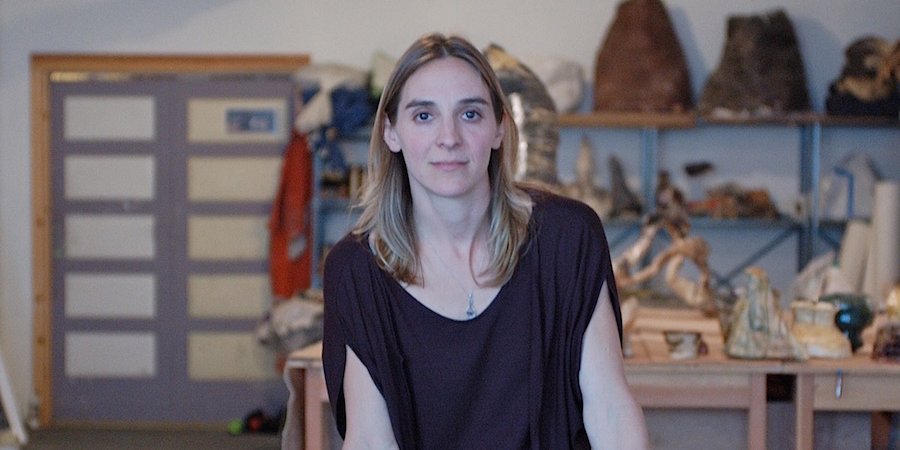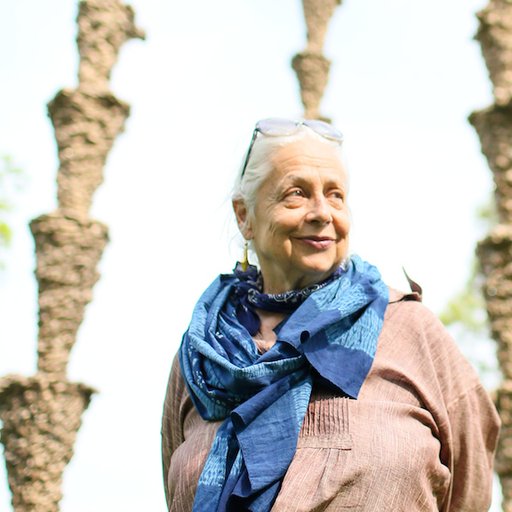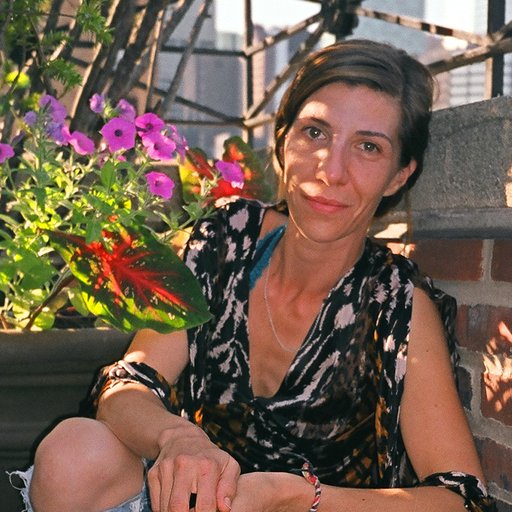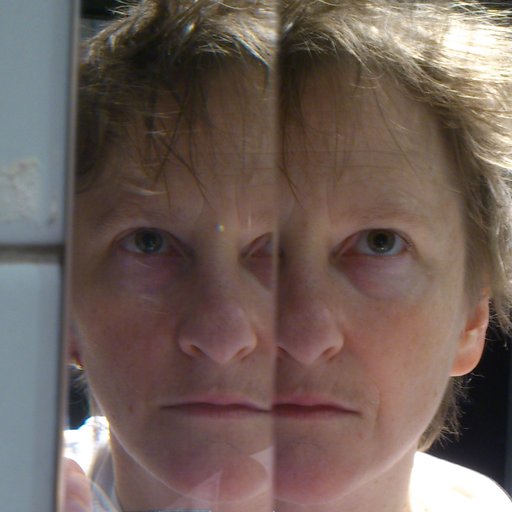The sculptor Jessica Jackson Hutchins stole the spotlight at the 2010 Whitney Biennial with a plucky piece of contemporary Americana, a sofa crowned with ceramic vessels and papered with news clippings about President Obama . The next few years found her on the move—from Portland to Berlin and then back again—along the way adjusting her mix of readymade and crafted objects to accommodate whatever was close at hand.
All that relocation and improvisation proved to be invigorating. Hutchins’s show this past spring at Marianne Boesky in Chelsea, her first with the gallery and her first appearance in New York in a half-decade, wowed critics with room after room of boisterous and confident works. Some, like the massive Ultrasuede Wave , were pieces of cushy upholstered furniture crushed by lumpen ceramic boulders; others, like Third Eye , were abstract paintings that veered off into Rauschenberg ian assemblage with folding chairs attached to their stretcher bars.
Both of these works will be on view next month in “Confessions,” Hutchins’s two-venue solo exhibition in Portland (at Reed College ’s Cooley Gallery and the collector-run space known as the lumber room .) It’s the first show in the Pacific Northwest for Hutchins, who lives in Portland with her musician husband Stephen Malkmus (the former Pavement frontman, now leading Stephen Malkmus and the Jicks ) and their children. Organized jointly by the local collector Sarah Miller Meigs and the Cooley Gallery curator Stephanie Snyder , “Confessions” is also an attempt to bridge public and private elements of the city’s nascent art scene.
In a wide-ranging conversation with Artspace , Hutchins spoke about the latest developments in the Portland gallery world, her interest in religions of all kinds, and the lofty inspirations for her art of "guttural physicality."
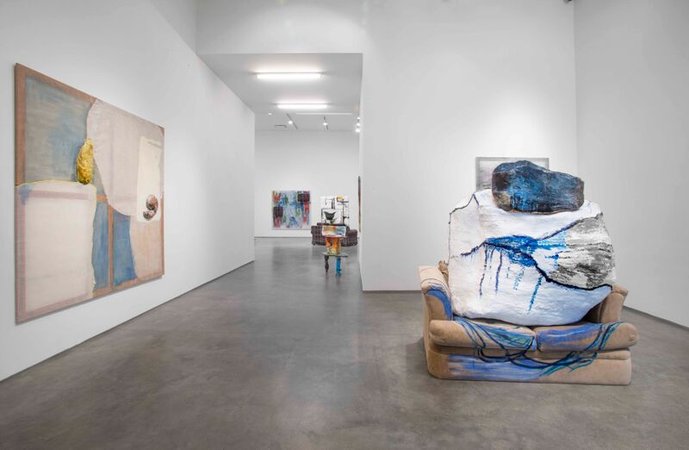 An installation shot of Jessica Jackson Hutchins's 2015 Marianne Boesky show (ditto all images that follow)
An installation shot of Jessica Jackson Hutchins's 2015 Marianne Boesky show (ditto all images that follow)
Your show at Boesky was your first in New York in five years, after a period of living and working in Europe and then a move to Portland. How did it feel to be back in the hothouse of Chelsea?
You know, I moved to Berlin for a couple of years. Then I moved back to the States, and was taking a while to make my shows. I had as much as I could handle in Europe—it was so exciting and expansive, but I did kind of feel like I missed New York. It still feels like my hometown. So it was really exciting and gratifying and fun to show there again.
That show did feel like a homecoming. It also introduced some new developments in your art—for instance, the wall-based works that seemed to speak the language of painting.
As often happens, it’s a result of a kind of dabbling around. I moved to Berlin without speaking any German or really knowing anyone. There was an art-supply store next door to my house, and I hadn’t found the hardware store yet. So I went to this art-supply store—I wandered around this place, every day, trying to figure out what was next. So it was sort of an accident, which is something I cultivate—the interactions with circumstance and materials that I find.
I started by buying some pre-stretched canvases and pastels. I would grind the pastel into the canvas, so it had its own sort of body. It was exciting—they felt like animal skins. They quickly came to be about the structure underneath, which also seems to be something I always end up working with. The stretcher was the main subject, in some way.
I was also trying to buy burlap in Berlin, and I accidentally bought this linen that was expensive and very beautiful. I ended up putting that on the stretcher bars like you would stretch a painting, but it was very transparent. You could see right through it, and so the stretcher bars behind it were a huge part of that story.
You were approaching painting as a sculptor.
Yeah. I don’t think I make paintings—paint is not the subject, and it’s not even a given that I’ll use it. All of the materials are in question—they’re not taken for granted. I look at the stretcher bar and I go, well, why should it look like that?
I did a show in Milwaukee where all the stretcher bars were different. The bars themselves had this sort of harmony to me—this harmonic system. There were six paintings and all the stretchers were different, but they moved in a progression. I had the Stations of the Cross in mind, both the Catholic idea and the Barnett Newman series.
Speaking of Newman, which other painters have you been thinking about?
I have always looked at so much painting. Agnes Martin comes to mind. Philip Guston , the soul and spirit of his work—the risk-taking, defiance. I look at a lot of Caravaggio, the voluptuousness of Caravaggio. Fra Angelico, that sort of moral rectitude and fragility. I look at a lot of painting, with great joy and gratitude.

What about artists outside painting? Rauschenberg is a reference that comes up a lot, when looking at your work.
That’s very unconscious, although I can see it. He has not been one of those artists who have made me swoon. I sense this goofy offhandedness and freedom in that work that I appreciate, but I would be a little too uptight to use such aggressive signifiers—like a goat. It becomes too narrative, too much about that signification. Rauschenberg’s Bed is painting on a bed—the bed that you sleep in, or, like Tracey Emin ’s bed, that you fuck in. When I put the fabric on the paintings, it’s a formal device and less the thing it used to be.
You’re not interested in narrative, but you are interested in religion. The Boesky show had a title from the New Testament—“I Do Choose,” from Mark:1:41—and your fall exhibition in Portland is called “Confessions.”
I was reading the Confessions of St. Augustine. I’ve been interested in all kinds of religious writings and practices for the last 20 years. I’ve made work about the Ramayana. I made work about Jillian of Norwich, who was an Anchorite.
A bunch of my early pieces were based on Saint Simeon Stylites. “Stylite” comes from stylos , or pillar. Saint Simeon was a Syrian monk—there’s a Pasolini movie about him [ Simon of the Desert , 1965], so it was really inspired by the Pasolini movie. There was an image of this guy who built pillars in the middle of town, to try to get closer to God and further from people in this very matter-of-fact physical way. I thought that was charming, direct, almost banal in its gesture. And then people would gather around, so he would have to make it higher and higher. The conflict between the worldly and ideal, the numinous and the gutturally physical, is a really huge theme for me.
I think there’s so much beauty in piety—and in the act of faith that it takes to be an artist. It makes you feel better when you’re working very, very long hours and there’s nobody interested. It’s the same experience as a monk’s—there’s no proof that what you are doing matters, but you believe that it matters.
What can you tell me about “Confessions,” which is split between two venues—one at Reed College, the other run by the Portland collector Sarah Miller Meigs?
It’s one show, in two locations. One of the locations, the lumber room, is Sarah’s private exhibition space. She has an eccentric but really complete collection of my work—from videos, and some of the first ceramics I made, up to a painting from that last show at Boesky. It’s almost a mini-retrospective. It’s not really meant to be—it just so happens that her collection is like that.
The part of the show that’s at Reed’s Cooley Gallery is more recent work—one of the pieces from Boesky is in there, the big Ultrasuede Wave , and some collages that I’ve been working on.
How do those two parts of the show link up? The Cooley Gallery describes “Confessions” as “a collective endeavor that seeks transparency about the distinctions between collecting, curating and making.”
It’s about relationships. I wouldn’t say my work is about those relationships, but seeing Sara’s collection certainly is. It’s a lot about Laurel Gitlen, too, who introduced us and started that relationship.
The museum and the collector had an interest in making it one show—I had to ask them, "Why?" They wanted to respect each other’s field of expertise, but also work in this symbiotic way that’s not about money or commerce. I guess they’re trying to suggest a different model. Everyone is really interested in what can be done, intellectually and aesthetically, for Portland.
What is the Portland scene like—what’s unique to its galleries, its collectors? How is it different from other places you’ve lived and worked?
There’s not so much money in Portland compared to other places, which is one of the reasons that it’s such a nice place to live. There’s all that bougie lifestyle stuff… I mean, culture is not the most important thing in Portland. Except, I guess, food—food culture is becoming such a big thing out here.
There is a nonprofit institution called Yale Union that’s definitely getting attention—I think one of their shows was on the cover of Frieze . They have this beautiful old laundry building, and they’re really doing new things. They’re pretty intellectual and theory-based—they have a lot of poets come. That is a different kind of thing in Portland, and it’s bringing a real vitality, I think.

What impact has living in Portland had on your art? When you first moved there, for instance, you started to work in ceramics.
I wanted to change my material—I wanted something beautiful and fragile. So I just took an adult-ed ceramics class.
As a sculptor who uses materials for what they are, I had a problem with glazing at first. It sort of goes back to painting—the glaze is a layer of glass that sits on top of your form. It was really hard for me to get behind that, because the glaze wasn’t intrinsic. And I was at a real craft college, where they would tell me all of these things I couldn’t do. All of that turned out to be nonsense, but it’s the way clay people talk. You can do anything; it’s just that you can’t be sure of the results.
Your work involves many different types of materials: found objects , papier mache, painting, ceramics. How have the relationships between them evolved? In your earlier works, like your 2010 Whitney Biennial piece Couch for a Long Time , the elements seemed relatively self-contained—vessels on a sofa. Now, everything seems to be intermingling.
The relationship between these kinds of objects and the ceramics have been going on for a while, so I’m probably pushing them harder in different places. There’s got to be an offhandedness, to keep that humor and defiance about them, as well as an attempt to be earnest and beautiful.
I like to think about Brancusi—there are the stacked pedestals in Brancusi’s work, and then there’s the apex, like the bird. Ultrasuede Wave is one piece, but it is a stack, one thing on top of another. Where the pedestal starts and ends is not so clear.

There's also a relationship, if a slightly ambiguous one, between the sculpted forms that rest on the objects and the human body.
The body is really present, without actually making a figure. I was in Chicago recently, and I went to the Charles Ray show. I loved it. I thought it was very beautiful how much it just focused on the figure, these very Classical looking figurative sculptures that had so much subtle humanity and humor and presence.
For me, the body is where the mystery of the making is for me. I said yesterday to a writer friend of mine that I don’t really believe in ideas. Ideas just seem like a dime a dozen—there’s a lack of magic. I wasn’t ever interested in linear narratives, either. My art has to escape the confinement of making sense, which is not only a drag but a means of oppression. So part of that is to let it come out of my body, and be about the body, which is where one’s vulnerability and awkwardness and humanity is.
Another reason that I like Christian metaphors—God is actually born as a baby and eats and farts and shits and dies and doubts in himself. The centrality of the body, in that, has always been really moving to me.
Given your interest in the body, have you thought about branching out into performance? I read that you considered making wearable ceramics for your show at the Hepworth Wakefield , in 2013, and ultimately decided not to.
I think that might happen eventually. It just has to be super-integral, necessary to the work. I have made these wearable ceramics, and the furniture wears them very effectively. An additional figure wearing them just didn’t seem that necessary at the time.
Also there’s a problem of language, when you have a human figure in there. It goes back to Charlie Ray. What is it doing, to put a literal figure in the room? It’s just a different mode altogether. I’m interested in a space that’s contemplative, that’s not literal.
As you suggest, performance can be implied in the work—the furniture is wearing the ceramics. And using furniture in your art, to begin with, is a way of making a kind of stage set for all sorts of human activity.
Absolutely, there’s a lot of theatricality in my work—and especially in this one show at the Hepworth Wakefield, where I very consciously amped it up. It was such a theatrical looking space, because it had no right angles. That was when I thought about making the ceramics wearable, but it all seemed a little gratuitous when you could just imply it and have this contemplative moment. It’s such a blessing to have a contemplative moment now and then.
I’ve also been thinking about the idea of a soundtrack, although that word, for art, seems so extraneous. I’ve been learning how to play the violin—there’s a lot of music in my house, music’s always been important to me, and it’s all over the art world. It would be a really great thing to get that right—I just don’t know what it would look like.
Speaking of your house, and of furniture: domesticity is a major theme of your art, and one that can be read in many different ways—as a feminist gesture, for instance, or as a reference to some personal experience, or a reaction to the sterility of the white cube.
I am a feminist, of course. And I’m a mother. So that is going to be there. But I think it’s mainly about intimacy and dialogue with the things around me. In Berlin it was art supplies, because I didn’t have a truck or my own furniture to take out of my house. When I drank a lot of beer I made work out of the beer cans and bottles. Then when I switched to coffee I made a lot of drawings from coffee cups.
I use things that have this tactile, intimate relationship to all of us. Not eccentric fancy things—just things that make you think, “I know what my butt feels like in a chair, I have one in my house, I can relate to this.”
It’s about reading meaning into all the things around us. It’s against purity. That’s one of the main reasons I started using this stuff around me—it compromises an aesthetic realm that’s distinct from that of your life. A chair is never going to be as beautiful as a Caravaggio, but I want to bring all of the highfalutin’ ideals of the Caravaggio down into the muck where we live.











